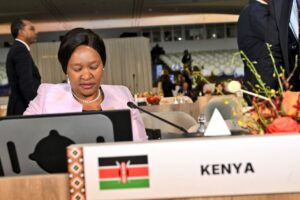Dr Fridah Govedi walked into the Kenya National Blood Transfusion Services (KNBTS) in early August last year, just a few days after the Centers for Disease Control and Prevention (CDC), Kenya stopped funding the department, and after the former director, Dr Josephine Githaiga, left in July.
A paediatrician by training, Dr Govedi had earlier worked as the medical superintendent of Kajiado County for five years.
Before that, she had served as the HIV/Aids and STI coordinator for Nairobi Province for two years, and as the CEO of Pumwani Hospital for six years.
The financial distress the department faces is not her fault, as the funding came to an end outside her tenure.
Also, the KNBTS is a department of the ministry and therefore cannot source its own funds.
DEFICIENT BILL
In 2013, the KNBTS, under the director at the time, Dr Margaret Oduor, got together with a few stakeholders and interested parties to draft a bill that would turn the department into a parastatal.
“I participated in the drafting of that bill,” says Justice (Rtd) Violet Mavisi. “The bill would turn the KNBTS into a professional institution that can be held accountable for the equitable distribution of blood across the country, and the safety of (donors and patients), and with a competitively appointed CEO.”
Kabogo condemns BBI politicians for mistreating Kuria
However, the new Constitution came into effect, and with it a new Health Act (2017), stalling the bill’s tabling. It is currently in Parliament as a private member’s bill sponsored by Murang’a Woman Rep Sabina Chege.
Dr Govedi agrees with the spirit of the bill, but says it is deficient. “It still has gaps,” she says.
She also takes fault with the leadership of the stakeholders’ committee, saying that as laypeople, they have no mandate to craft a technical bill.
PARTNER SUPPORT
This is despite the fact that it was the KNBTS, through its first director Dr Oduor, that approached the stakeholders to form the committee in 2013.
Justice Mavisi says the bill is the solution. “Had this bill been passed when it was first tabled, the department would have found a way out of this crisis, even if it means engaging hospitals to cater for blood transfusions through NHIF.”
KNBTS staff say that while the legal issues are being hashed out, there is still enough goodwill from corporates, individuals and others to ensure that blood keeps being collected, screened and distributed.
On December 18 last year, the then acting director-general for health, Dr Wekesa Masasabi, issued a circular instructing all five regional BTS managers to use partner support to ensure there would be sufficient blood stocks over the Christmas period.
“Things went well and the blood situation stabilised,” offers a staff member.
CONSULTATION FIRST
On January 10, Dr Govedi called her first staff meeting since her installation and told them that no partners should be engaged until they had been referred to her for vetting and formalisation of their relationship with KNBTS.
“The system has been working for years before she came,” says a staff member. “Our activities are purely by outreach, and we use partners to mobilise the public to donate blood, to train staff, to make sure we were up to date with best practice. Why change now?”
The Saturday Nation asked Dr Govedi this question: “KNBTS didn’t know about these arrangements with partners.”
“We had no clear engagement with them. This is because the CDC was controlling those partnerships. And you cannot say the system was working before – the KNBTS was only collecting 164,000 units a year, when the target was half a million.”
As far as she is concerned, partners have no mandate unless they have been cleared by her. “If you want to solve a government problem, you have to engage the government. Let them come to me directly. My door is always open.”
LACKING EXPERTISE
However, per the agreement the KNBTS had with the CDC, the Service would identify partners to work with, chosen through a public tender system and vetted for capacity, and the CDC would fund the partners’ activities on the strength of KNBTS’ recommendation.
This system has worked since 2004 when it was set up. “All the records she needs on prior engagement with partners are in her office,” says the staff member.
“What happened to institutional memory?” asks a former partner. Part of the problem, says the staff member, is that Dr Govedi has not gone through the requisite training to understand how the system works.
“All staff get to travel to other countries such as Rwanda and South Africa to observe successful blood bank
Without this specialised training, it is almost impossible to understand professional blood management.
We ask Dr Govedi about this. “Blood is a health subject and as a paediatrician, I am a user of blood. Blood is a part of basic training. I learned how to read blood slides for my master’s, also. Why would you want that training when you are seasoned in the field?”
Meanwhile, Rwanda’s blood bank has survived and thrived since the US ceased funding it, and is now successfully delivering blood to recipients in remote areas via drones.
NEW LEADERSHIP
Might it not be useful to use that example to assist Kenya’s blood bank to get back on its feet?
“I don’t want to benchmark against Rwanda,” says Dr Govedi. “Their terrain and circumstances are different.”
Meanwhile, the Ministry of Health does not seem to have made any efforts to address the urgent situation, which is this: at this very moment, the entire country only has 7,500 units of blood for use.
It is many stakeholders’ hope that the incoming Cabinet Secretary Mutahi Kagwe will work urgently to change things while policies are put in place to streamline operations at the Service.
— Additional reporting by Nasibo Kabale
Mourners ferried from Coast to attend Moi memorial serviceKabogo condemns BBI politicians for mistreating Kuria






















